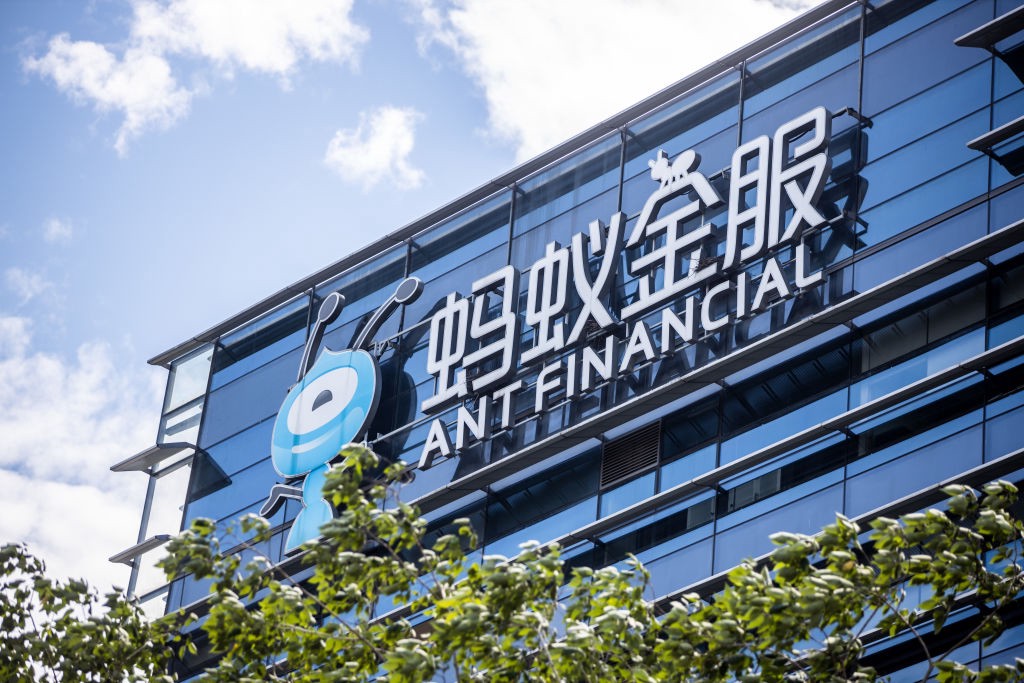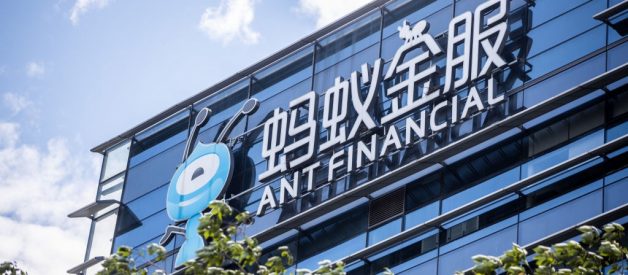Alibaba built the ?Amazon of the East.? Now, its fintech spinoff is set to be the biggest IPO of the year.
 A logo hangs on a building of Ant Group, a leading provider of financial services technology in China, on July 23, 2020 in Hangzhou, Zhejiang Province of China. Photo: Wu Jun/VCG/Getty Images
A logo hangs on a building of Ant Group, a leading provider of financial services technology in China, on July 23, 2020 in Hangzhou, Zhejiang Province of China. Photo: Wu Jun/VCG/Getty Images
In an IPO market that?s on fire, the biggest is yet to come: Ant Group, a Chinese online payments giant, created by Alibaba founder, Jack Ma. The company filed for its IPO this week and is expected to be the most valuable company ever to go public on a global stock exchange. The company plans to sell 10% of its shares on Shanghai?s Nasdaq-like exchange and 5% on the Hong Kong Stock Exchange, according to MarketWatch.
The Chinese company is looking to raise a record-breaking $30 billion in its IPO, which is expected to happen by October (for context, Saudi Arabia?s oil giant, Aramco, raised $25.6 billion in its IPO last December).
Ant Group is the fintech to beat all fintechs, and the success of its IPO will be determined by how the market perceives its tech relative to its fin. The company is the ultimate mashup between Stripe, PayPal, Apple Pay, Venmo, FICO, and any of the multiple fintech companies in the U.S. that offer lending, savings, and insurance products. While the stocks of tech companies have risen strongly over the past few months with the Nasdaq up roughly 25% above where it was in February, the stocks of financial companies, like U.S. Bancorp and PNC, have languished. Meanwhile, with an estimated $200 billion valuation, Ant Group is worth more than most global banks. Here?s how Ant Group became the largest fintech company in the world.
Why Fintech Companies Like Square and Stripe Are Thriving Right Now
Here?s why the economic downturn is actually benefiting payments and lending startups
marker.medium.com
What is Ant Group?
Ant Financial, now known as Ant Group, was founded in 2004 by Jack Ma. It was five years after he founded Alibaba, China?s largest e-commerce company often hailed as the Amazon of the East. Ma had identified a problem of customer trust, which was impeding growth in his e-commerce business. Given relatively weak consumer protection laws in China and deteriorating consumer confidence around quality control, people were reluctant to buy goods online. So Jack Ma established mobile-payment platform Alipay as an intermediary that would keep the buyer?s money in escrow until satisfactory delivery was made, after which the money would be transferred to the seller. It was like PayPal, but with a much lower threshold for adoption given the paucity of alternatives.
Last year, Alibaba generated about $38.3 billion of sales in a single day over its Global Shopping Festival, the world?s largest 24-hour online sale held annually on November 11 to celebrate Singles Day, an anti-Valentine?s Day holiday celebrating single people that is popular in many Asian countries. Coresight Research reports that this Festival, alone, generates more sales than Black Friday and Cyber Monday combined.
By the end of 2006, more than 300,000 merchants were accepting Alipay as an independent payment method including gaming companies, travel websites, and online stores.
As Alipay was effectively functioning as Alibaba?s growth engine, it was also able to cultivate its own network of merchants. China?s digital payment infrastructure was relatively undeveloped, with cash usage still very high in the early 2000s. Alipay expanded outside the Alibaba footprint to facilitate other online transactions. By the end of 2006, more than 300,000 merchants were accepting Alipay as an independent payment method including gaming companies, travel websites, and online stores. User numbers rose quickly, and in 2010 the payment method received official government endorsement, allowing it to develop largely free of compliance costs and regulatory restrictions.
Shopify Saved Main Street. Next Stop: Taking on Amazon
The Canadian e-commerce company is breathing down Silicon Valley?s neck as the next great enterprise behemoth
marker.medium.com
Today, Alipay has 1.3 billion annual active users (compared to 346 million active PayPal accounts worldwide). The majority are in its home market of China, but the company also has over 300 million users across India, Thailand, South Korea, the Philippines, Bangladesh, Hong Kong, Malaysia, Indonesia, and Pakistan. It has a 54% share of the Chinese digital payments market, which in total did volumes of about $33 trillion last year. (The next biggest player is Tencent with 39%.)
Those volumes include a lot of transactions besides retail. There are also peer-to-peer payments (similar to Venmo), transfers between a user?s own accounts, and payment for financial services and utility bills. But within retail, digital payments make up a large chunk of transactions. Much of that is online, in keeping with Jack Ma?s original goal of launching Alipay to propel e-commerce, but digital payments are increasingly being used in the offline world, too. The number of QR code payments has skyrocketed in China, helped by promotions mounted by Alipay and its peers.
From Alipay to Ant Financial
While Alipay created huge value for Alibaba by reducing friction in e-commerce, it didn?t initially capture much value for itself. Even today, Alipay takes a heavily discounted fee on the payments it executes for Alibaba, and peer-to-peer payments are free. In an interview in March, the company?s CEO, Simon Hu, said that 50% of daily transactions are free.
Alipay built its financial services strategy around two resources: access to data and access to customer funds.
To capture value, it needed to retain control of customer funds. Alipay pays upfront cost every time users upload money to the system ? a 0.1% fee levied by the user?s bank. To cover that cost, it needs to retain the funds for as long as possible. In the early days, Alipay could reinvest funds left in user accounts to earn interest for itself. However, the Chinese government gradually removed that opportunity, requiring Alipay to park funds in a low-interest custodial account within the banking system.
So the company turned to other financial services. Alipay built its financial services strategy around two resources: access to data and access to customer funds. In 2014 it restructured as Ant Financial and raised private capital. It obtained a license to operate a new banking business, MYbank, and promoted its money market fund, Yu?e Bao (pronounced yoo-uh-bow), which it had launched a year earlier.
Since the beginning of 2019, digital financial services have generated more revenue than payments. Today, Ant Group manages over $560 billion in wealth management. Approximately a quarter of that is managed in-house as part of the Yu?e Bao money market fund, which gained popularity as a place for consumers to park spare cash at an enhanced interest rate through a few clicks on their smartphone (Yu?e Bao translates as ?leftover treasure?). Chinese consumers now treat the fund like a checking account. Initially it offered an interest rate of 5% at a time when banks were offering only 2.75% on deposits. Since then rates have come down and, subject to increased regulatory scrutiny, the company imposed a cap on investment amounts.
How Jio Became the Darling of Silicon Valley
Why have Facebook and Google invested billions into an Indian telecom company?
marker.medium.com
Leveraging customer data
Ant Group?s second key resource, data, is harnessed through the company?s credit scoring service, Zhima Credit (or Sesame Credit). The service generates credit scores based on public data but also taps into alternative data such as relocation trends, money transfers, shopping activities, and even social relationships. The score is useful not just for obtaining credit but to give customers access to car rental or hotel booking services, and to borrow more mundane items like umbrellas and portable phone chargers from local stores, all without a deposit. A good credit score even exempts customers from having to apply for a visa if they want to visit certain countries like Singapore and Luxembourg (they?d need a score of 700 for that, in a range of 350 to 950).
The credit score provides another lever on top of payments functionality to enhance customer retention. But it is not a profit center in and of itself. Rather, its value comes via Ant Group?s lending business. Here the company is focused on small ticket loans to consumers and small businesses, which it is able to offer quickly. Lending is currently the biggest revenue driver of the company, contributing nearly 40% of revenue in the first six months of 2020. (The company has also recently added insurance products, capitalizing on the current low levels of insurance penetration in China.)
Everything You Need to Know About Lemonade Going Public
The insurance tech company IPOs at a $1.5B valuation. Is it worth it?
marker.medium.com
In total Ant Group offers products across five business areas ? payments, wealth management, credit scoring, lending, and insurance. Its cross-selling has been near perfect. According to the company, ?the vast majority of Ant Group?s digital payment users were also digital financial services users.? The company has also said that 80% of customers use three or more financial services, and 40% use all five services.
From Ant Financial to Ant Technology
Ahead of its IPO, Ant Financial has rebranded itself again, into Ant Technology. It released a three-year plan in March centered on opening up the Ant ecosystem to a wider selection of partners, not just financial institutions. Its new app incorporates local services like food delivery, transport, and medical services, reflecting the degree to which the company hopes to become ensconced in its users? daily lives. Somewhat ominously, a company spokesman told The Guardian, ?The idea is people are living their lives through this platform.?
In this latest iteration, Ant Group is further fortifying its moat. However, this could become a liability. Although regulators have tended to lag behind fintech developments in China in the past, policymakers in China are already putting more pressure on Ant. Its IPO prospectus cautions of ?evolving regulatory regimes, which may negatively affect our business and prospects.? The company?s decision against listing in the U.S. also reflects growing tensions in U.S.-China trade relations and increased scrutiny of Chinese companies by the Trump administration. All the more reason why investors will be closely watching this IPO.
This is an abridged version of an in-depth analysis that was previously published on Net Interest.


